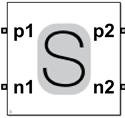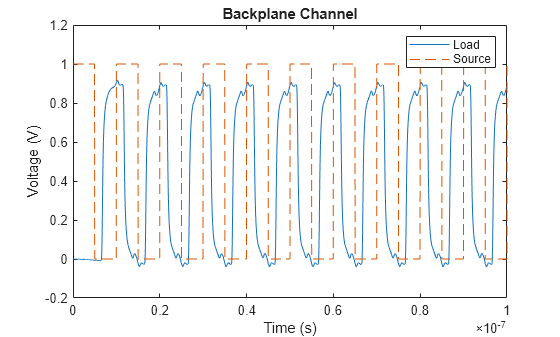S-Parameter Rational Fit
Implement rational fit approximation to S-parameter description of linear system
Since R2024b
Libraries:
Simscape /
Electrical /
Passive
Description
The S-Parameter Rational Fit block implements a rational
approximation of a linear system characterized with scattering parameters (S-parameters).
S-parameters describe the frequency behavior of a system. For more information about the
S-parameters format, see Data Import and Network Parameters (RF Toolbox). For more information about how to calculate
S-parameters, see sparameters (RF Toolbox).
The S-Parameter Rational Fit block operates with passband signals. If you need to simulate a baseband signal, a frequency band limited signal superimposed on a carrier frequency, use the S-Parameters (RF Blockset) block with other blocks in the RF Blockset™ Circuit Envelope library instead. For more information about the relationship between baseband and passband signals, see the Passband Signal Representation in Circuit Envelope (RF Blockset) example. For more information about using blocks in the Circuit Envelope library, see Circuit Envelope Simulation (RF Blockset).
You define the rational fit by specifying a value for the Rational fit object parameter. There are two ways to construct a rational fit object:
You can fit a
rationalfunction object to the component data using therational(RF Toolbox) function.You can use the
rfmodel.rational(RF Toolbox) constructor to specify the pole-residue representation of the component directly. Use therationalfit(RF Toolbox) function to return anrfmodel.rationalobject.
Note
To run a simulation that uses a rational or
rfmodel.rational object as a parameter value in the S-Parameter
Rational Fit block you must have RF Toolbox™ installed.
rational (RF Toolbox) is
recommended over rationalfit because it enables faster simulation and
has improved fitting controls.
For testing purposes, you can also specify the rational fit object as:
The empty set
[]— This option creates a nonreflective rational system with no cross-coupling between ports. All ports present an impedance to the external circuit equal to the value of the Reference impedance (Ohm) parameter.A square constant matrix with dimensions equal to the number of ports — This matrix defines the constant term connecting the ports. A matrix of zeros is equivalent to the empty set option and an entry of
1in the (i,j) element implies a direct feedthrough from port j to port i.
Note
In this context, a "port" refers to a pair of terminals connecting two electrical networks. This definition is common in the telecommunications industry. By this definition, a single "port" represents two "conserving ports" in the Simscape™ family of products.
You can specify the number of ports by setting the value of the Number of
ports parameter. Limit this value to 33. Higher values
significantly increase compilation and simulation time. Higher order rational fits also
increase the compilation and simulation time. If the rest of your model is linear or switched
linear, avoid including delay terms in the rational fit object so that the
S-Parameter Rational Fit block also uses linear equations.
For more information about checking your model for blocks with nonlinear equations, see
simscape.findNonlinearBlocks.
Equations
This figure shows the four-element S-parameter matrix for a two-port device.
In this figure:
ai is the incident power wave from port i.
bi is the reflected power wave from port i.
Sij is the transmission coefficient that indicates how much of the signal that enters the network at port j transmits to port i.
The block assumes that all the reference impedances are equal and have a real scalar value. These equations describe the relationship between the incident power wave and the reflected power waves at each port over a range of frequencies,
where:
Vi is the voltage at port i relative to the ground.
Z0 is the value of the Reference impedance (Ohm) parameter.
Ii is the current through port i.
The rational object approximates the frequency responses
Sij by rational transfer functions of the
form,
where:
s is the angular frequency.
Ck are the residues.
Ak are the poles.
D is the direct term.
Examples
Ports
Conserving
Parameters
Extended Capabilities
Version History
Introduced in R2024b

